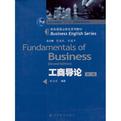工商导论
出版时间:2009-2 出版社:高等教育出版社 作者:陈准民 页数:238
前言
《工商导论》自2002年出版以来,商务英语又有了很大的发展。首先,中国加入世界贸易组织之后,社会对商务英语人才的需求继续加大,促使越来越多的高等院校与时俱进,开设商务英语专业或方向,以更好地满足国家改革开放的需要。根据一份调查(李朝、赵函,2005),到2005年全国开设商务英语专业(方向)的高校已达547所,占所调查1,607所高校的34%。2007年以来,教育部又批准对外经济贸易大学等院校试办独立的商务英语专业。从办学层次上看,大专、本科和研究生都有。第二,商务英语的师资队伍不断壮大。从最近三届(即第五、第六和第七届)的“全国国际商务英语研讨会”的参会人数可以看出,越来越多的英语教师参加到了商务英语的教学和研究行列,新人不断涌现。第三,商务英语的学术研究从理论到实践均取得长足进展,成果丰硕。 在这种大形势下,高等教育出版社决定对“十五”国家级规划教材“商务英语系列教材”进行修订,是非常必要和及时的。拙作《工商导论》作为这个系列中的一本也做了修订。 首先,第二版对教材的有关内容进行了更新。近几年,在企业形式、国际贸易、金融货币、国际化经营、知识产权、信息管理等领域都有了不少新的发展,因此,本教材的有关章节也作了相应调整,对相关数据进行了更新。其次,结合第一版的使用情况和院校反馈,对部分案例分析和翻译练习做了修订,在增强其针对性和时效性同时,对第一版中的一些排版和印刷错误也作了更正。 商务英语是一个日新月异、充满活力的领域。相关教材也应通过实践不断修订,与时俱进。因此,我衷心希望各位同行和专家一如既往地关注这本教材,不吝赐教。
内容概要
本书作为商务英语专业的一门概论型基础课程教材,全面、系统、概要地介绍了国际经贸理论和知识。本书主要供普通高等教育商务英语专业学生,以及国际贸易、国际经济、国际工商管理等外向型专业的学生使用,同时也可供从事国际商贸工作的人员参考使用。
作者简介
陈准民,对外经济贸易大学教授,教育部高等学校外语专业教学指导委员会委员,英语分委员会副主任,中国国际贸易学会国际商务英语研究会主任。长期从事商务英语教学,在商务英语教学理论、教学法改革、教材编写、师资培训、计算机辅助教学等方面有多年研究,为商务英语学科带头人。 主要讲授商务英语、经济管理和计算机应用等课程,如经贸英语口语、对外经贸信函、工商导论、工商教育中的教学法、互联网与经贸英语等。 独立编写并出版了《工商导论》、《实用经贸英语口语》、《英语生意经》、《模拟期货贸易》等教材和计算机辅助教学软件,在国内外学术刊物上发表科研论文多篇。
书籍目录
Chapter 1 Setting Up a Business Sole Proprietorship Partnership Corporation A Special Form: FranchisingChapter 2 Marketing: an Overview The Origin of Marketing The Functions of Marketing The Marketing Mix Market SegmentationChapter3 Products and Pricing Types of Products Product Life Cycle PricingChapter4 Channels6fDistHbution Common Channels of Distribution The Cost and Value of Middlemen Physical Distribution Modes of TransportationChapter 5 Promotion Advertising Do It Yourself or Use an Advertising Agency Personal Selling Sales Promotion Public Relations and Publicity Word of MouthChapter6 Moneyand Banking What Is Money? What Does Money Do? Types of Money The Financial System Savings and Loan Associations Money Supply and the Federal Reserve SystemChapter 7 Financing Short-term Financing Long-term Sources of Funds Debt or Equity Financing Features of Bonds Features of StockChapter 8 Accounting Balance Sheet Income StatementChapter9 The Securities Market Primary and Secondary Markets Buying and Selling Stocks Bulls and Bears The Bond Market Who Buy Securities?Chapter 10 Risk Management and Insurance Approaches to Managing Business Risks Insurance and Its Principles Insurable Risks Insurance for Business Fidelity and Surety BondsChapter 11 Business Law Types of Law Contract Law Tort Law Property Law Warranty Negotiable Instruments Agency Law Business BankruptcyChapter 13 International Business Why Trade with Other Countries? Other Ways to Go Global Special Issues in International BusinessChapter 13 Managing Business Enterprises Management Functions Management Levels and Skills Sources of Managers The Building Blocks of Organizational Structure Organizational Decision Making Organizational Structures Informal Organization The Strategic Management ProcessChapter 14 Human ResourcesManacjement Planning for Human Resources Staffing Training and Developing Employees Demoting and Terminating Employees Compensating EmployeesChapter 15 Motivation and Leadership ! The Classical Theory The Hawthorne Studies Maslow's Hierarchy of Human Needs Herzberg's Two-factor Theory McGregor's Theory X and Theory Ouchi's Theory Z Strategies for Motivating Employees LeadershipChapter 16 Managing Information Information vs. Data How Computers Work? Application Programs The Management Information System (MIS)Chapter 17 The Environment and Responsibilities Factors of Production Types of Economic System Economic Goals and How to Measure Their Attainment The Roles of Government The Market and Competition The Importance of Profits The Responsibility of BusinessChapter 18 Careers in Business Self-evaluation Career Opportunities in Business Successful Job Hunting Key to Exercises of Cloze and Scrambled Sentences Key to Translation References
章节摘录
As an economy develops, it needs a growing supply of money. Theincrease of money supply, however, must not be let go unchecked. Whenthe growth rate of a countrys money supply exceeds that of its economy,its money will decline in value, resulting in inflation. Therefore, moderngovernments have devised many instruments to regulate the money supplyfor sustainable economic growth. In the United States, such instruments areat the disposal of the Federal Reserve System, popularly called the Fed, andthe most frequently used instruments are reserve requirements, changes inthe discount rates, and open-market operations. First, commercial banks are required to store some of their funds(a reserve) either in their own vault or as deposit with their local FederalReserve Banks. In order to control the money supply, the Fed can adjustreserve requirements for commercial banks. Higher reserve requirementsmean that banks have less money to lend, and reduce the expansion ofmoney. Lower requirements, conversely, will result in an increased supplyof money. The Fed also acts as the commercial bankers bank. When commercialbanks need money, they can borrow from the Federal Reserve Banks andpay interest on the loans. The rate of interest charged by the Fed is calleddiscount rate. If the Fed wants to reduce the money supply, it increases thediscount rate, making borrowing more expensive and bank loan-makingless attractive. Low discount rates, on the other hand, encourage borrowingand lending, resulting in expansion of the money supply. Changes in thediscount rate cause more subtle shifts in the money supply than do changesin the reserve requirement. Therefore, the Fed uses this tool frequently. Inthe 1980s, for instance, the Fed adjusted the discount rates considerably. The third instrument the Fed can use to control the money supply isits open-market operations. When it wants to increase the money supply,the Fed buys securities from dealers. The dealers banks are credited for thetransactions, so the banks have more money to lend and this expands themoney supply. To decrease the supply of money, the Fed sells securities.Open-market operations are the most effective tools of control becausethey act quickly and predictably.
图书封面
评论、评分、阅读与下载
用户评论 (总计22条)
- 适合商务英语的学生阅读的好书。。不过,,里面的事例是用外国的。
- 书不错,用作教材,对于商业英语的词汇增加很有帮助。
- 当时教授在课堂上大力推荐使用的一本书,特别容易上手
- 商英班的教材。买回来自学。
- 老师也是用这本书上课。。。
- 老师钦点的书哦
- 师姐说这本很好~~
- 书很实用,非常喜欢
- 老师指定用书,内容其实还真不错
- 内容很精确
- 学到了很多东西,设计的也很好,每个单元都留了一页白纸,刚好做笔记用
- 书店找了好久都没有 终于在这里找到了 很好的书
- 书非常的好。同学们都很满意。送货也很快。
- 速度非常快 书也很棒
- 订的第二天就到了,快!不错!
- 我从当当买的书质量不错书很新运送也很好希望当当继续发展我会继续在当当选购的!!
- 很新很正版
- 书很正版也送的很快,谢谢。。。
- 本书作为商务英语专业的一门概论型基础课程教材,全面、系统、概要地介绍了国际经贸理论和知识。本书主要供普通高等教育商务英语专业学生,以及国际贸易、国际经济、国际工商管理等外向型专业的学生使用,同时也可供从事国际商贸工作的人员参考使用。本书只是教材,跟我想象的有点差距,不过,对于应考BEC,应该已经很有帮助了.
- 里边介绍了工商类需要知道的基础知识,而且是纯英文,作为教材或者写作素材都有一定帮助,但是要完全读下来,可能就需要很大的毅力了。
- 专业用书~印刷质量很好内容也还可以
- 还可以、、速度慢了点。
推荐图书
- 比较与翻译
- 管理的真相
- 日本历代著名诗人评介
- 图说经典
- 影响世界历史的100件大事
- 三十六计
- 孙子兵法
- 图说经典
- 会计-2009年注册会计师考试考前最后六套题
- 2009年注册会计师考试考前最后六套题
- 2009年注册会计师考试考前最后六套题
- 2009年注册会计师考试考前最后六套题
- 税法-2009年注册会计师考试考前最后六套题-2009年注册会计师全国统一考试辅导用书-轻松过关4-适用于新考试制度下考生使用
- 2009年注册会计师考试考前最后六套题
- 图说 中国地理速读
- 电子制作从想法到实现
- 告别甘地
- 笑的历史
- 家装全攻略
- 材质选用
- 中国村官
- 我所亲历的中苏大论战
- 家具与陈设
- 金陵古韵
- 2009在职攻读硕士学位学位全国联考英语考试语法词汇完形填人专项
相关图书
- 英语报刊选读
- 新编实用英语视听说初级教程(下)
- 周末读完意大利史
- 中国国旗礼仪
- 国际财务管理
- 佐罗
- 外教社西班牙语分级注释读物
- 外教社西班牙语分级注释读物
- 21世纪高职高专财务会计专业系列教材
- 外教社西班牙语分级注释读物
- 外教社西班牙语分级注释读物
- 外教社西班牙语分级注释读物
- 外国语文教学与研究.6
- 英语专业本科生系列教材修订版
- 现代卷-不可不读的20世纪中国短篇小说-3
- 不可不读的20世纪中国短篇小说(现代卷4)
- 现代卷-20世纪中国短篇小说精选-5
- 不可不读的20世纪中国短篇小说(当代卷2)
- 21世纪研究生教育规划教材
- 节日长安((全10册)
- 高校党课教程
- 课堂检测
- 大学生就业概论
- 廉政文化概论
- 法语章法研究
